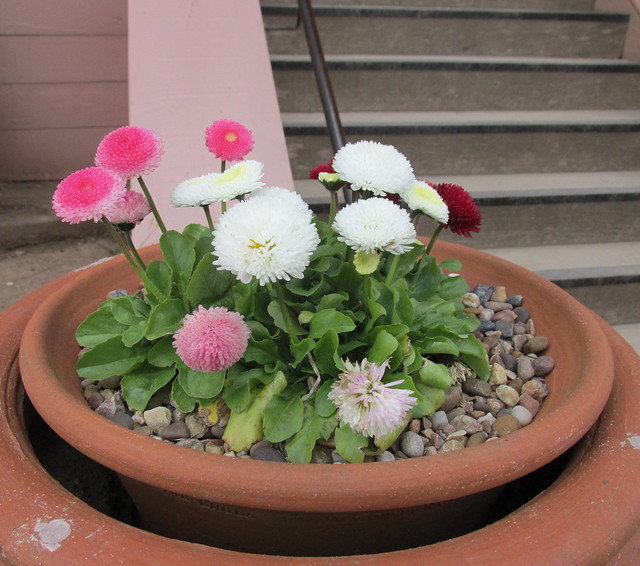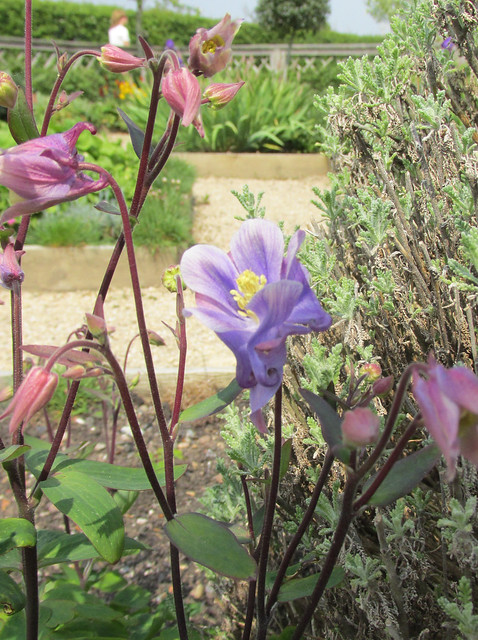There's rosemary, that's for remembrance. Pray you, love,
remember. And there is pansies, that's for thoughts.
There's fennel for you, and columbines. There's rue for you,
and here's some for me. We may call it herb of grace o' Sundays.
O, you must wear your rue with a difference! There's a daisy. I
would give you some violets, but they wither'd all when my father
died. They say he made a good end.
Of course Ophelia was quite mad, and grieving over her father's death, when she made this speech in Hamlet, but the fact that Shakespeare included such a rich and symbolic reference to flowers shows how important they were in Elizabethan culture.
I made a recent visit to Kenilworth's Elizabethan Garden and covered the archaeological and historical background in my other blog. What I didn't say much about was the variety of flowers and plants I found there.
The idea of using flowers as symbols goes back as far as the Old Testament of the Hebrew Bible. By Elizabethan times the social norms of the day prevented normal communications, particularly between potential lovers, so much was said using the code of floriography, or the language of flowers.
Robert Dudley's great garden of love has been reconstructed using contemporary sources to ensure its authenticity. It contains very many 'hidden' messages to the Queen he created it for. Here are some examples:
Let's start with the ones that Ophelia mentions. First rosemary. Like I said, she was madly remembering her father's death, but in Dudley's case this would have been to tell Elizabeth that she was always in his thoughts.
Daisies are a difficult topic because they have very many meanings. They can mean unhappy or forsaken love, as Ophelia implies about Hamlet, but they can also mean innocence. So Dudley could have been praising his Virgin Queen. And red daisies stand for beauty that is unknown to its possessor. Now there's a bit fat piece of flattery. QEI wasn't exactly pretty, if you study her portraits, but Dudley would have told her she was, as part of his campaign to win power.
Here's aquilegia, or columbine. This one symbolises innocence as well. Its name 'columbine' derives from the Latin for dove, because the flower is said to resemble four doves. I can't see it, frankly, but there you go. However, there's a religious link to the christian Holy Spirit, which is also symbolised by a dove. Hence purity and innocence.
The grassy bank below the viewing terrace is packed with primroses. Not only does it make for a very pretty sight (there are cowslips in among them too - representing grace) but it also screams "I will love you forever. I can't live without you" to anyone who understands the message. The flower's Latin name Primula means 'the first', because it is among the earliest flowers to appear in spring. But that was also used to imply that a person is 'first' in another's thoughts.
And finally we come to a bit of a cheat, because I'm going to talk about the hedges as one item, even though they have several species in them. Traditionally the hedges around Elizabethan knot gardens would have been box, but its meaning is stoicism, which isn't too romantic. True, Dudley had to be a bit of a stoic to keep up his pursuit of the queen's hand for as long as he did, even though he never succeeded, but that wouldn't have been too complimentary to her. So the hedges at Kenilworth include hawthorn and holly. Hawthorn stands for hope and holly for domestic happiness. How clear a message is that?
I've done a bit of research for this post, not just at Kenilworth itself but also online. Thanks to Wikipedia (as ever) but also to this page which refers to “The Garden of the Renaissance: Botanical Symbolism in Italian Painting” by Mirella Levi D’ancona.
Thanks as always to Amy at Love Made My Home for organising the Five on Friday . Take yourself off there to see what other people have to offer. Click here to be taken there.





What a fascinating post. I love to know all the symbolism and meaning about flowers. Thank you. B x
ReplyDeleteFascinating. The portraits of the time contain so much symbolism too don't they. In Reading Museum there's one of Elizabeth that Dudley commissioned at the time of the Kenilworth festivities.http://www.readingmuseum.org.uk/news/2014/jun/queen-elizabeth-portrait-back-show/ :-)
ReplyDeleteWhat a beautiful post, the language of flowers such a delight. You have certainly got me thinking that I would like to learn more and perhaps use it in some of my crafting projects. Thank you for sharing.
ReplyDeleteThank you for this gorgeous post!
ReplyDeleteHave a lovely weekend!
Fascinating - I have been debating whether to order a book from Amazon about the language of flowers and your post has encouraged me to do so. xx
ReplyDeleteReconstruction of historical gardens from documents is interesting.I would like to see this one. I knew some of the symbolism of flowers, but you've introduced me to a few more examples. It was clever of Dudley to commission this knot garden as a means of communicating his love and loyalty to Elizabeth I even though the flattery didn't pay off in the end after the Amy Robsart affair. I've been wondering about that statue, looking at it more closely on your other blog. What do the figures represent, especially that spikey ball?
ReplyDeleteYou can find Langham's description of the fountain here which describes various water god type references such as Neptune and Triton. I suspect the "Athlants" translate as residents of Atlantis. The spiky bits are where the water flows out of the fountain when it's running. The very top part (the 'ragged staff') is part of Dudley's coat of arms, I think.
DeleteThank you for the link as well as the other links on this post - fascinating follow-up reading.
DeleteThank you for this very interesting post! I saved your link and shall study it more thoroughly. The symbolism of flowers is fascinating indeed.
ReplyDeleteFascinating post. The language of flowers is something I've just diped into on occasion but I would love to learn much more about it. I loved this garden at Kenilworth when we visited a few years ago, so much of interest there and how clever of Dudley to use the hedges as well as flowers to convey his message. The aquilegias are innocently taking over our garden at the moment:)
ReplyDeleteI love this post, so informative and fascinating. I will put this to good use in 'drop in' conversations with my family , thank you x
ReplyDeleteWonderful post. I love that flowers can 'speak' to someone. It is really fascinating. Thanks for sharing!
ReplyDeleteThis post was so much fun to read and learn about the different hidden messages. I found a book the other day about the hidden messages of flowers. Not only are the flowers and plants in this garden beautiful but the history that goes along with it is fascinating. Have a wonderful day! Pat xx
ReplyDeleteInteresting post. I am particularly drawn to the primrose as that is my daughter's middle name. She rather reluctantly agrees that she likes it, although when anyone new discovers her name they are a bit surprised as she is a bit of a tomboy!
ReplyDeleteCaz xx
Great post. How complex is the language of flowers!
ReplyDeleteYour post is full of interesting information. The "romance" between Dudley and QE1 has always fascinated me. I never knew about this garden. Thank you for all the research!
ReplyDeleteYou did a lovely post! I used to study the significance and uses of flowers and herbs because I was so immersed in early American history, living in Virginia, and working at two historic houses. I really enjoyed it! The origins in Europe and other parts of the world is so fascinating. I think the double meaning of rue in Ophelia's speech is great, too. So many double meanings there! I'm popping over to your link!
ReplyDeleteAbsolutely fascinating!! I had no idea about the history behind the meaning of flowers. We have lots of primroses, so I really like the meaning behind them. Thank you for joining Five On Friday, I hope you are having a good weekend. Sorry to be late visiting, I have been otherwise occupied as I said in my post. xx
ReplyDelete